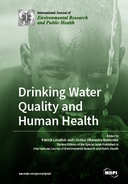Explore

Drinking Water Quality and Human Health
0 Ungluers have
Faved this Work
Login to Fave
The quality of drinking water is paramount for public health. Despite important improvements in the last decades, access to safe drinking water is not universal. The World Health Organization estimates that almost 10% of the population in the world do not have access to improved drinking water sources. Among other diseases, waterborne infections cause diarrhea, which kills nearly one million people every year, mostly children under 5 years of age. On the other hand, chemical pollution is a concern in high-income countries and an increasing problem in low- and middle-income countries. Exposure to chemicals in drinking water may lead to a range of chronic non-communicable diseases (e.g., cancer, cardiovascular disease), adverse reproductive outcomes, and effects on children’s health (e.g., neurodevelopment), among other health effects. Although drinking water quality is regulated and monitored in many countries, increasing knowledge leads to the need for reviewing standards and guidelines on a nearly permanent basis, both for regulated and newly identified contaminants. Drinking water standards are mostly based on animal toxicity data, and more robust epidemiologic studies with accurate exposure assessment are needed. The current risk assessment paradigm dealing mostly with one-by-one chemicals dismisses the potential synergisms or interactions from exposures to mixtures of contaminants, particularly at the low-exposure range. Thus, evidence is needed on exposure and health effects of mixtures of contaminants in drinking water. Finally, water stress and water quality problems are expected to increase in the coming years due to climate change and increasing water demand by population growth, and new evidence is needed to design appropriate adaptation policies.This Special Issue of International Journal of Environmental Research and Public Health (IJERPH) focuses on the current state of knowledge on the links between drinking water quality and human health.
This book is included in DOAB.
Why read this book? Have your say.
You must be logged in to comment.
Rights Information
Are you the author or publisher of this work? If so, you can claim it as yours by registering as an Unglue.it rights holder.Downloads
This work has been downloaded 962 times via unglue.it ebook links.
- 292 - pdf (CC BY-NC-ND) at Unglue.it.
Keywords
- acute gastroenteritis
- adverse reproductive outcomes
- ammonia
- animal feeding operation
- annual effective dose
- arsenic
- Asia-Pacific region
- atrazine
- biomonitoring
- Calcium
- Cancer
- carcinogenic
- chemical oxygen demand
- chemical risk assessment
- chlorination by-product
- Chronic Kidney Disease
- community water system
- cough
- Denmark
- dental health
- diarrhea
- diarrhoeal disease
- disinfection by-product
- dissolved oxygen
- drinking water
- drinking water distribution systems
- drinking water guidance
- drinking water quality
- drug labels
- duration extrapolation
- E. coli
- effect measure modification
- end-stage renal disease
- endocrine disruptor
- endogenous nitrosation
- enterococci
- Environment
- environmental exposure
- exposure assessment
- fecal coliforms
- fever
- fluoride
- France
- gravity-fed piped water scheme
- Groundwater
- health insurance data
- health-based guideline
- Human health
- HWTS implementation
- impact assessment
- infant exposure
- infant health
- Infants
- inorganic manganese
- low birth weight
- LTD
- magnesium
- Maryland
- methemoglobinemia
- Monitoring
- N-nitroso compounds
- Nigeria
- nitrate
- nitrite
- organic matter
- pharmaceuticals
- pharmacokinetic modeling
- Potassium
- Preterm Birth
- private wells
- Public Health
- Radioactivity
- Risk
- Risk assessment
- risk context
- Risk management
- rural water resources
- sanitary inspection
- screening method
- seasonality
- simulation study
- small for gestational age
- sodium
- space–time detection
- spatial variations
- sub-Saharan Africa
- tap water
- THMs
- thyroid disease
- time series study
- trihalomethanes
- turbidity
- uncertainty factors
- urban area
- Vibrio pathogens
- water and sanitation
- water contaminants
- water contamination
- water operation data
- water safety plan
- water safety plans
- waterborne disease outbreak
- Zinc
Links
DOI: 10.3390/books978-3-03897-727-8Editions

